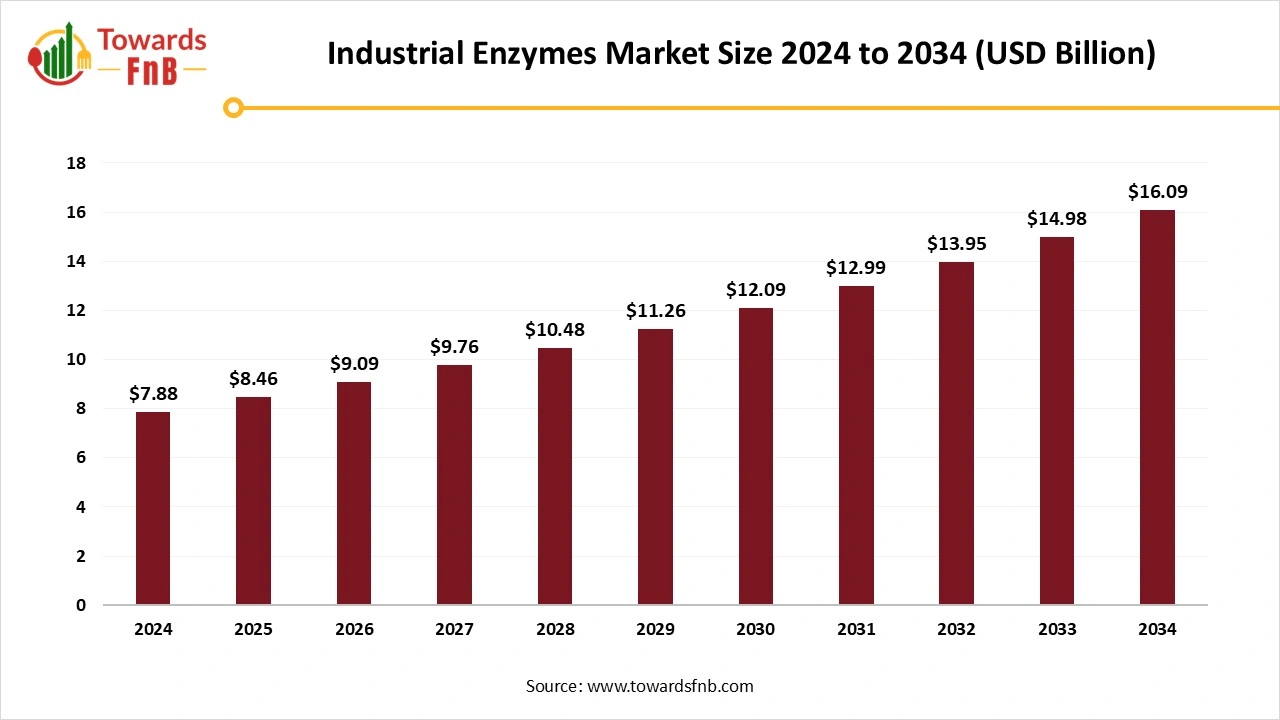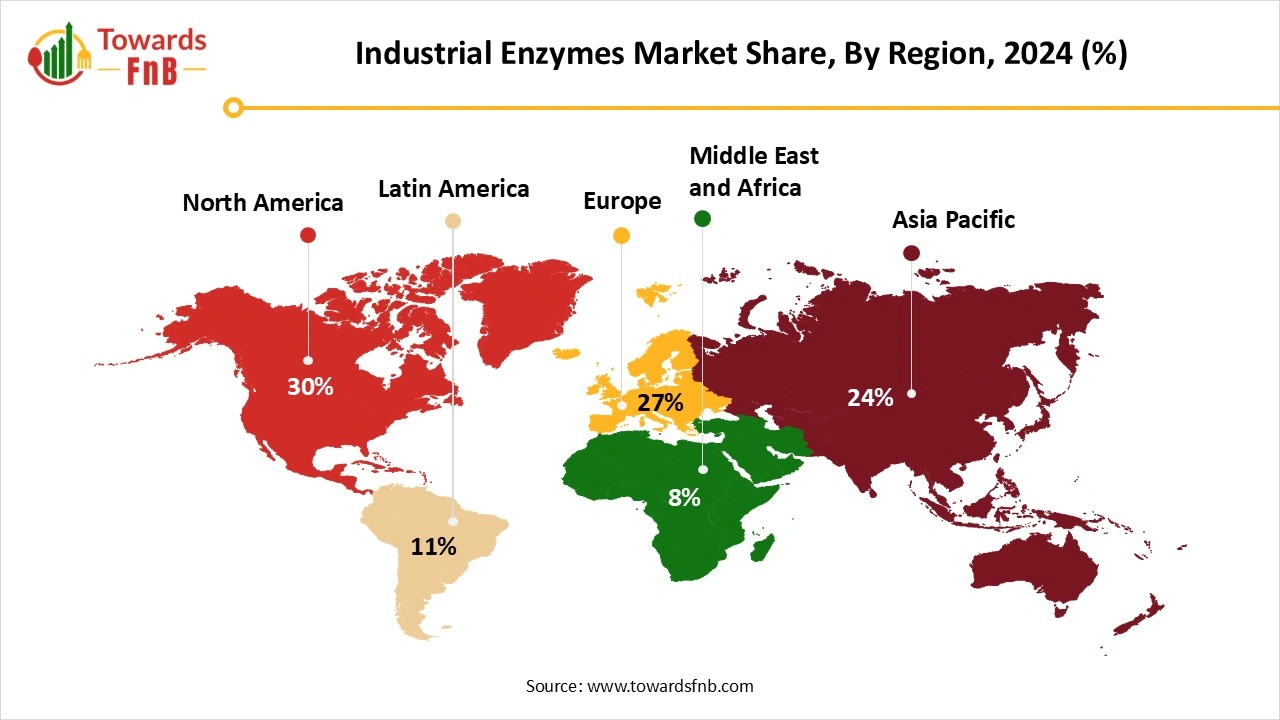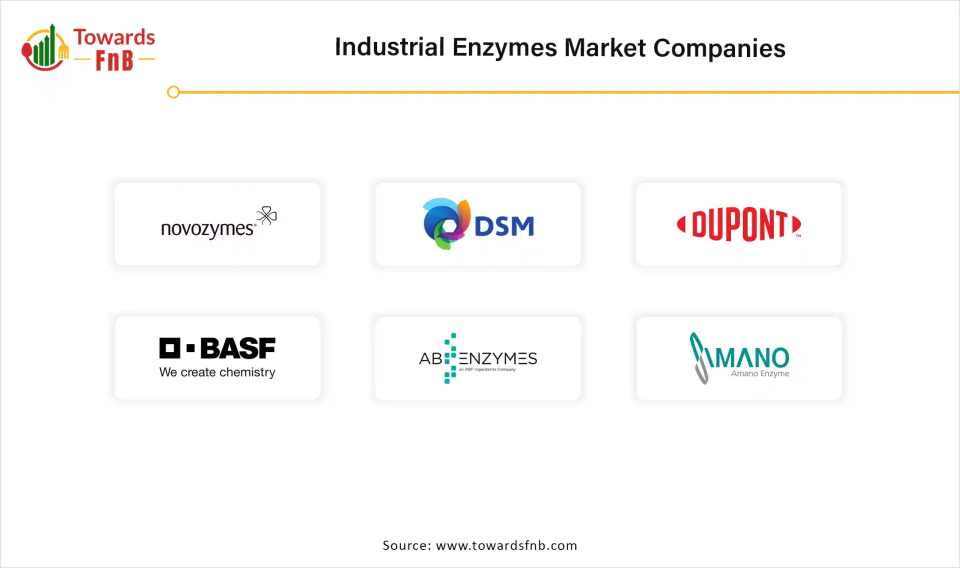December 2025
The global industrial enzymes market size was calculated at USD 7.88 billion in 2024 and is expected to rise from USD 8.46 billion in 2025 to nearly reaching USD 16.09 billion by 2034, growing at a CAGR of 7.4% during the forecast period from 2025 to 2034. The market is expanding due to growing consumer demand for the sustainable and efficient production process and increasing demand for the various sectors such as food & beverages, biofuel, pharmaceutical, animal feed and detergents.

| Study Coverage | Details |
| Growth Rate from 2025 to 2034 | CAGR of 7.4% |
| Market Size in 2025 | USD 8.46 Billion |
| Market Size in 2026 | USD 9.09 Billion |
| Market Size by 2034 | USD 16.09 Billion |
| Largest Market | North America |
| Base Year | 2024 |
| Forecast Period | 2025 to 2034 |
| Regions Covered | North America, Europe, Asia-Pacific, Latin America, and Middle East & Africa |
Industrial enzymes are biocatalysts that speed up chemical reactions in various industrial processes. These enzymes are derived from microorganisms and are used to enhance the efficiency of chemical reactions in industries such as food & beverages, textiles, detergents, pharmaceuticals, and biofuels. They play an essential role in various applications due to their ability to catalyze specific reactions under mild conditions, reducing energy consumption and improving sustainability. Proteases, cellulases, amylases, lipases, β-galactosidase, glucanase, pectin lyase, and ureases are frequently utilized in different industries.
Enzymes are currently utilized to produce over 700 commercial items. Products and solutions based on enzymes are utilized in more than 40 industry sectors, including household care such as detergents, bioenergy, agriculture, animal health, and food. The use of enzymes in food encompasses brewing, baking, beverage production, wine, juice, dairy products, and oils fats.
New sectors like bioplastics, wastewater management, and farming are also utilizing enzyme-driven solutions, generating additional growth opportunities. Emphasizing sustainability and environmentally friendly methods is a major factor, with enzymes significantly contributing to decreased chemical use and lower energy consumption. Creating microbial fermentation processes for the economical production of recombinant lipases or investigating alternative enzyme sources, like enzyme immobilization on low-cost supports, can reduce production expenses and enhance scalability for pharmaceutical production. There is substantial potential for expansion in emerging markets where the application of industrial enzymes is still evolving. Working together with research organizations and additional firms can result in findings and uses for enzymes.
The production of enzymes entails intricate fermentation and purification processes, leading to elevated expenses. These costs restrict enzyme availability, particularly for small and medium businesses, hindering market expansion even with rising demand. These expenses arise from intricate fermentation and purification procedures, along with the cost of raw materials, resulting in elevated enzyme prices and possibly impeding their uptake, especially in budget-conscious sectors.
North America Dominated the Industrial Enzymes Market in 2024.
The increasing need for industrial enzymes in North America is driven by a strong emphasis on sustainable production, energy efficiency, and reducing chemical usage. Companies are increasingly adopting enzyme-driven methods to diminish their environmental impact and boost efficiency. The presence of large-scale enzyme producers, rising demand for processed food, and continuous advancements in enzyme engineering further contribute to the market's expansion. Due to regulatory measures promoting green technologies, industrial enzymes are increasingly gaining traction in the U.S. and Canada.
Industrial enzymes are currently at the forefront of transforming food and beverage production throughout the United States, fueled by consumer demand for clean-label, nutritious, and functional food. Proteases, amylases, and lipases are extensively utilized in various applications including baking, brewing, dairy processing, and dietary supplements. The increasing focus on renewable energy sources is boosting the demand for industrial enzymes used in the manufacture of biofuels, especially ethanol and biodiesel, enhancing the demand for industrial enzymes in the United States market. The expansion of enzyme applications into unconventional sectors is evident in their increasing utilization in industrial cleaning and textile manufacturing. Enzymes are extensively utilized instead of harsh chemicals in laundry detergents, textile desizing, and leather processing due to their biodegradability and specificity to substrates.

Asia Pacific Expects Significant Growth During the Forecast Period.
The Asia Pacific industrial enzymes market is experiencing significant expansion driven by multiple essential elements. The rising demand for processed food and beverages in developing countries like China, India, and Indonesia is a significant factor. Enzymes enhance food quality, extend shelf-life, and boost production efficiency, making them essential to food processing. Moreover, increasing environmental issues and the transition to environmentally friendly and sustainable industrial practices have hastened the use of enzymes in sectors like textiles, biofuels, and paper & pulp. The increase in disposable income, urban growth, and enhanced healthcare facilities are indirectly raising enzyme demand in the area.
The rising need for bio-based products, broader uses in food and drink, textiles, and biofuel sectors, ongoing progress in enzyme engineering, adoption of government measures supporting industrial biotechnology, and heightened awareness of sustainable manufacturing methods are key elements boosting India’s industrial enzymes market share. Enzymes enhance the nutrient quality and digestibility of animal feed, resulting in improved feed conversion ratios, accelerated growth rates, and overall animal well-being. India hosts 20% of the global cattle and buffalo population and 11% of the world’s goat and sheep population, making the industry abundant in raw resources. In the fiscal year 2020-21, India's footwear, leather, and leather goods exports totaled $3.68 billion.
India's leather sector is experiencing a notable transition towards embracing biotechnological approaches, such as the application of enzymes. These biological catalysts originate from various sources, such as fungi and bacteria, and are specially designed to focus on different processes in leather manufacturing. As the need for eco-friendly leather goods increases, the market for enzymes in this industry is swiftly growing. Importers, exporters, distributors, wholesalers, manufacturers, and dealers are progressively acknowledging the benefits of integrating enzymatic solutions into their production procedures.
Which Type of the Enzyme Dominated the Industrial Enzymes Market in 2024?
Amylases segment led the industrial enzymes market in 2024. Amylases are among the most researched industrial enzymes, and their requirements in different industrial sectors are steadily growing each day. Numerous enzymes exhibiting various structural and functional diversity are found in the amylase family. Although amylases exist in both plants and animals, microbial sources like bacteria and fungi are favored for industrial production because of their high yields, simple cultivation, and capability to be easily tailored for uses. Amylase is an extensively utilized industrial enzyme because it can decompose starch into simpler sugars, rendering it beneficial in numerous applications such as food, fermentation, and textile processing.
Protease Segment is Observed to Grow at the Fastest Rate During the Forecast Period.
Protease enzymes are poised to demonstrate significant growth potential in the food sector due to their capacity to enhance flavor and texture, optimize metabolism, and increase the nutritional quality of foods. Consequently, due to swift urbanization and busier lifestyles, one forthcoming requirement for protease would be its heightened application in promoting gut health within the body. Various proteases, including bromelain, ficin, actinidin, papain, and calpain, are frequently utilized in the food sector to enhance meat tenderness via proteolytic degradation.
How Microbial Enzymes Segment Dominated the Industrial Enzymes Market in 2024?
Microbial enzymes segment held the dominating share of the industrial enzymes market in 2024. Microbial enzymes are favored because of their cost-effectiveness, high production rates, reliability, simplicity of product enhancement and refinement, constant availability owing to no seasonal variations, swift microbial growth on low-cost media, durability, and superior catalytic efficiency. Factors contributing to the use of microbial enzymes in industrial applications include rising consumer goods demand, the necessity for cost reduction, depletion of natural resources, and ensuring environmental safety. Microorganisms are preferred sources for industrial enzymes because of their easy accessibility and rapid growth rate. Recombinant DNA technology allows for straightforward genetic modifications in microbial cells to enhance enzyme production and foster scientific advancement.
Plant-Based Enzymes Segment is Seen to Grow at a Notable Rate During the Predicted Timeframe.
This market trend arises from their natural source, safety characteristics, and alignment with consumer preferences for clean-label, animal-free items. Their use covers the nutraceutical, food, and cosmetic sectors, where plant-derived proteases such as bromelain and papain are preferred for digestive support and anti-inflammatory effects. Advancements in plant tissue culture and transgenic expression systems are enhancing enzyme production and stability.
What Made the Food & Beverages Segment Dominant Segment of the Industrial Enzymes Market in 2024?
Food & beverages segment dominated the market with the largest share in 2024. The food & beverages sector is one of the main industries that serves the demands of the expanding population. The extensive assortment of packaged foods, including dairy items, drinks, meat, poultry, and seafood, is greatly fragmented. Enzymes are typically employed to facilitate production when foods are packaged for commercial use. Enzymes have significantly transformed the processing of food and beverages, enabling natural, efficient, and sustainable solutions. Enzymes improve the taste, appearance, and quality of food and drinks. They often make baked products look airier, their crumb textures remain consistently even, while the milks turn creamier and provide a more enjoyable sensory experience for the consumers in the dairy.
Biofuels Segment is Expected to Grow at the Fastest Rate in the Market During the Forecast Period.
The increasing concerns regarding energy security and the necessity to reduce greenhouse gas emissions are key factors influencing the expansion of the biofuel. In response to the rising demand for biofuels, innovative biochemical methods utilizing enzymes are being created, attracting greater global interest. For instance, the production of biodiesel through enzymatic catalysis requires less energy and is more eco-friendly than the production using traditional alkaline catalysis. Enzymes have recently been used in biofuel production to address the limitations typically linked to traditional chemically catalyzed methods.
Which Form of the Industrial Enzymes Held the Largest Share of the Industrial Enzymes Market in 2024?
Liquid enzymes segment held the largest share of the market in 2024. The widespread use of liquid enzyme formulations is mainly influenced by their exceptional solubility, convenient application, and efficiency in various industrial procedures. The food and beverage sector continues to be the biggest consumer, using liquid enzymes for operations such as juice clarification, starch conversion, and dairy processing. In processes such as detergent manufacturing, liquid enzymes dissolve rapidly, enhancing stain elimination and boosting washing effectiveness at reduced temperatures.
Granular Enzymes Segment is Observed to Grow at the Fastest CAGR During the Forecast Period.
Granules provide more precise and uniform dosing than powders, which may be susceptible to clumping and irregular distribution. Granules are typically simpler to manage, move, and store than liquid or powder versions, making the entire process easier for industrial users. Granules enable more precise and uniform dosing compared to powders, which may be susceptible to clumping and inconsistent distribution.
Why did the Hydrolases Segment Dominate in 2024?
Hydrolases segment led the market in 2024. A primary factor behind the prevalence of Hydrolases is their capacity to identify and cleave specific chemical bonds within substrates, leading to efficient and controlled reactions. This precision not only boosts the efficiency of industrial operations but also minimizes waste and increases product output. Hydrolases have greater industrial significance than other enzyme classes, possessing the largest proportion of enzymes utilized for industrial applications. Close to 75% of all enzymes used in industry are hydrolytic enzymes. Numerous industrial sectors, including the detergent, textiles, leather, pulp and food and feed, paper, dairy, biofuels, and waste management industries, rely on hydrolases. Hydrolases are enzymes that facilitate hydrolysis reactions, dismantling complex molecules through the addition of water molecules. This essential skill renders them vital in numerous industrial operations.
Oxidoreductases Segment is Seen to Grow at a Notable CAGR During the Forecast Period.
The need for oxidoreductases is driven by their various uses in biotechnology, where they contribute to creating novel approaches in drug production, environmental conservation, and agricultural improvement. A key driver for the oxidoreductases market's growth is the burgeoning pharmaceutical sector. Oxidoreductases are essential in drug synthesis, providing remarkable specificity and effectiveness.
ThyssenKrupp
dsm-firmenich
Creative Enzymes

By Type
By Source
By Application
By Form
By Function
By Region
December 2025
December 2025
December 2025
December 2025